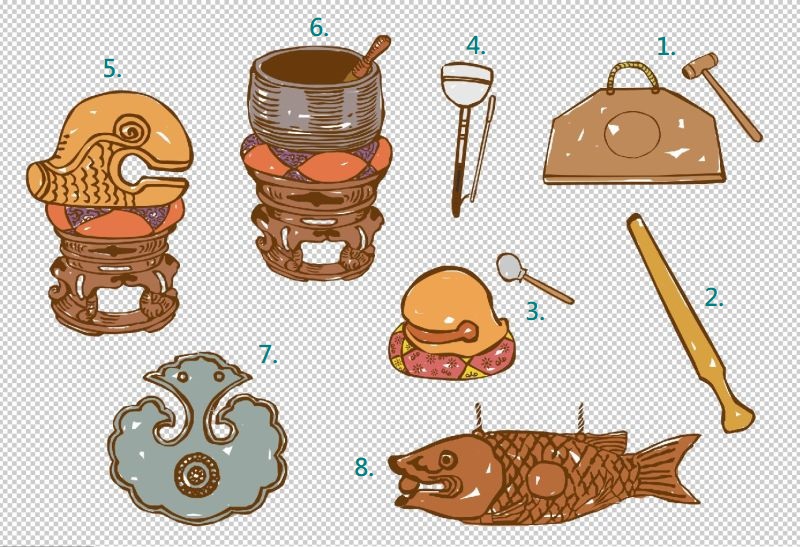Special Topics
Dharma Instruments Used in Meditation Retreats
Speaking is prohibited throughout the entire course of meditation. In addition, Dharma instruments are used to signal the timetable, instructions and change of activities. When explaining the rules for the meditation hall, the monastic instructor will also give an introduction on the purposes of different Dharma instruments, as well as the expected response upon hearing them.
1. Percussion Board
The percussion board is an essential tool during the retreat. It is used to signal the time to get up in the morning, finish chores, and retire to bed in the evening.
2. Incense board
Shaped like a sword, the Incense board is an elongated plank of wood that is used for maintaining order in the meditation hall. If practitioners are not sitting in the correct posture or dozes off, the retreat monitor will use it to remind them to adjust their posture.
3. Small fish
The wooden fish comes in large and small sizes, where the smallest-sized is known as the "small fish". Usually, the retreat monitor will strike the small fish three times to signal the start of a meditation session.
 4. Hand bell
4. Hand bell
Sounding the hand bell signals the conclusion of a meditation session, at which point practitioners may leave theircushions to have a drink of water or use the restroom.
5. Large fish
The large fish is only used in the Morning and Evening services.
6. Singing bowl
The singing bowl is only used in the Morning and Evening services.
7. Cloud-shaped gong
Usually made of bronze and shaped like a cloud, the cloud-shaped gong is struck to signal the time to dine, at which point retreatants should prepare to enter the dining hall.
8. Fish gong
Carved out of wood and made into the shape of a fish, the gish gong is usually hung alongside, and struck in sync with, the cloud-shaped gong, to signal the time for dining.
Extended Reading:
1. Q&A for Meditation Beginners
2. Five Basic Trainings for Meditation Practice
3. What are the Regulations in the Meditation Hall?
4. A Guide to Meditation Practice
5. Dharma Instruments Used in Meditation Retreats
Resource: Issue 370 of Life Magazine, Dharma Drum Publishing Corporation
Translation: Cheng-Yu Chang (張振郁)
Editing: Chia-cheng Chang (張家誠), Keith Brown
1. Percussion Board
The percussion board is an essential tool during the retreat. It is used to signal the time to get up in the morning, finish chores, and retire to bed in the evening.
2. Incense board
Shaped like a sword, the Incense board is an elongated plank of wood that is used for maintaining order in the meditation hall. If practitioners are not sitting in the correct posture or dozes off, the retreat monitor will use it to remind them to adjust their posture.
3. Small fish
The wooden fish comes in large and small sizes, where the smallest-sized is known as the "small fish". Usually, the retreat monitor will strike the small fish three times to signal the start of a meditation session.
 4. Hand bell
4. Hand bellSounding the hand bell signals the conclusion of a meditation session, at which point practitioners may leave theircushions to have a drink of water or use the restroom.
5. Large fish
The large fish is only used in the Morning and Evening services.
6. Singing bowl
The singing bowl is only used in the Morning and Evening services.
7. Cloud-shaped gong
Usually made of bronze and shaped like a cloud, the cloud-shaped gong is struck to signal the time to dine, at which point retreatants should prepare to enter the dining hall.
8. Fish gong
Carved out of wood and made into the shape of a fish, the gish gong is usually hung alongside, and struck in sync with, the cloud-shaped gong, to signal the time for dining.
Extended Reading:
1. Q&A for Meditation Beginners
2. Five Basic Trainings for Meditation Practice
3. What are the Regulations in the Meditation Hall?
4. A Guide to Meditation Practice
5. Dharma Instruments Used in Meditation Retreats
Resource: Issue 370 of Life Magazine, Dharma Drum Publishing Corporation
Translation: Cheng-Yu Chang (張振郁)
Editing: Chia-cheng Chang (張家誠), Keith Brown
